
|
You entered: Saturn's Moon
 Mars, Antares, Moon, and Saturn
Mars, Antares, Moon, and Saturn
4.10.2014
Mars, Antares, Moon, and Saturn are the brightest celestial beacons in this serene sky. The Sun's golden light is still scattered along the southwestern horizon though, captured after sunset on September 28.
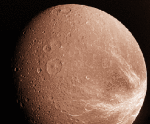 Saturn's Moon Dione
Saturn's Moon Dione
9.10.1995
Dione, one of Saturn's larger moons, is remarkable for its bright surface streaks. These streaks run across some of Dione's many craters, which indicate that the process which created the streaks occurred later than the process which created the craters.
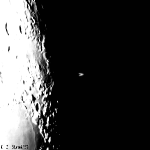 Moon Occults Saturn
Moon Occults Saturn
24.09.1997
Many stargazers in the U. S. were able to watch a lovely lunar occultation early last Thursday morning as a bright Moon passed in front of Saturn. Using a 1.2 meter reflector, astronomer Kris Stanek had an excellent view of this dream-like event from the Whipple Observatory atop Arizona's Mount Hopkins.
 Saturn with Moons Tethys and Dione
Saturn with Moons Tethys and Dione
31.05.1997
Saturn and two of its larger moons - Tethys and Dione - were photographed by the Voyager 1 spacecraft which flew by the planet in November of 1980. This picture gives an indication of Saturn's extensive ring system, which can be seen casting a shadow on the planet, as does Tethys.
 Epimetheus and Janus: Interchangeable Moons of Saturn
Epimetheus and Janus: Interchangeable Moons of Saturn
2.11.2005
These two moons change places. Epimetheus and Janus, two small moons of Saturn, actually switch positions as they orbit their home planet. The orbital radii of the moons are strangely separated by less than the radii of the moons themselves: about 50 kilometers. One moon orbits Saturn well ahead of the other, at first.
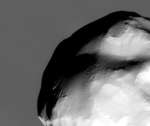 Saturns Moon Helene from Cassini
Saturns Moon Helene from Cassini
10.03.2010
What's happening on the surface of Saturn's moon Helene? The moon was imaged in unprecedented detail last week as the robotic Cassini spacecraft orbiting Saturn swooped to within two Earth diameters of the diminutive moon.
 Moon Occults Saturn
Moon Occults Saturn
8.05.1999
On September 18, 1997, many stargazers in the U. S. were able to watch a lovely early morning lunar occultation as a bright Moon passed in front of Saturn. Using a 1.2 meter reflector, astronomer Kris Stanek had an excellent view of this dream-like event from the Whipple Observatory atop Arizona's Mount Hopkins.
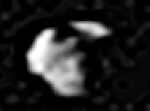 Dione's Lagrange Moon Helene
Dione's Lagrange Moon Helene
10.10.1995
Saturn's moon Helene is very unusual in that it circles Saturn near the orbit of a bigger moon: Dione. Helene is situated in what is called a "Lagrange point" of Dione - a place of stability created by Dione's gravity.
 Saturns Moon Rhea from Cassini
Saturns Moon Rhea from Cassini
15.02.2005
Each moon of Saturn seems to come with its own mystery. Rhea, Saturn's second largest moon behind Titan, shows unusual wisps, visible above as light colored streaks. Higher resolution images of the wisps show them to be made of long braided fractures.
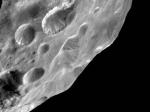 Unusual Layers on Saturns Moon Phoebe
Unusual Layers on Saturns Moon Phoebe
14.06.2004
What caused the unusual light and dark layers on Saturn's moon Phoebe? The layers were discovered just Friday during the Cassini spacecraft flyby of the small moon. Such layering is particularly evident on the crater just above the image center, where alternating light and dark material makes this crater appear particularly structured.
|
January February March April |
|||||||||||||||||||||||||||||||||||||||||||||||||